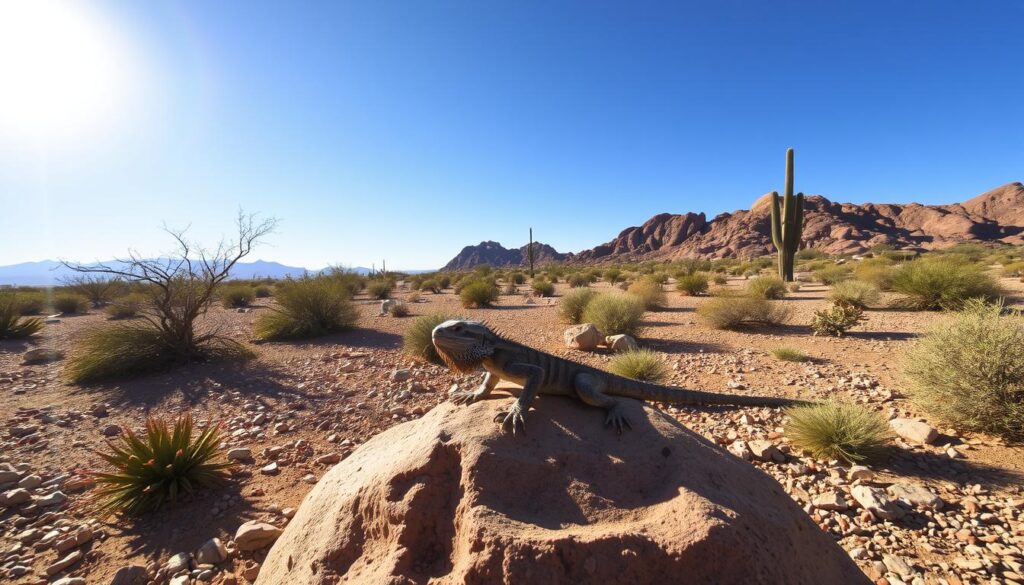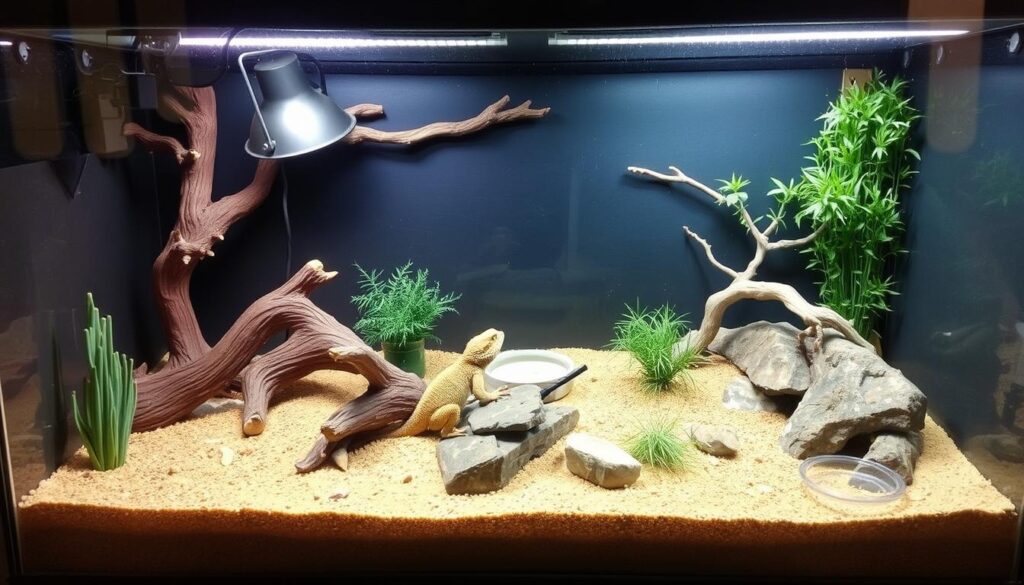Do Bearded Dragons Need Heat At Night
Bearded dragons can handle temperatures as low as 50°F (11°C) at night. This shows how important it is to know their heating needs. In their natural home, the Australian desert, night temperatures change a lot with the seasons.
Bearded dragons need outside heat to keep their body temperature right. Using ceramic heat emitters or low-wattage red night bulbs can help a lot. This guide will dive into how they regulate their temperature and give tips for keeping them warm at night.
Understanding Bearded Dragon Temperature Requirements
Keeping the right temperature in a bearded dragon’s home is key for their health. These reptiles need their environment to control their body heat. This is important for digestion, immune function, and more.
Importance of Temperature Regulation
Bearded dragons need the right temperature. During the day, they should bask in a warm spot between 40-42°C (104-107°F). This helps with digestion and other important functions. The cooler part of their home should be around 22-25°C (71-77°F). This lets them adjust their body temperature as needed.
Impact on Health and Behavior
Wrong temperatures can harm a bearded dragon’s health and behavior. If it’s too cold, they might feel tired, have bad digestion, and get sick more easily. On the other hand, too much heat can stress them out, make them stop eating, and even cause serious health problems. It’s vital to keep the ideal bearded dragon tank temperature for their happiness and long life.
The Science Behind Bearded Dragon Thermoregulation
Bearded dragons are ectothermic reptiles. They need outside heat to control their body temperature. This is key for their health and digestion.
They move between warm and cool spots to keep their body temperature right. This is called thermoregulation.
When it’s about 36.9°C (98.4°F), bearded dragons start gaping. This is how they regulate their temperature. Adults are better at this than young ones.
Research shows that a bearded dragon’s heart beats faster when it gets warmer. It beats slower when it gets cooler. Males and females have different temperature ranges for thermoregulation.
Bearded dragons adjust their posture to stay warm. They can even change their skin color to absorb more heat. The size of their mouth opening shows how fast they want to warm up.
Adults are more skilled at keeping their body temperature stable. This helps them survive in both the wild and captivity.
| Thermoregulation Behavior | Temperature Range |
|---|---|
| Gaping | 33°C to 35°C (91°F to 95°F) |
| Heart Rate Increase | 6.22 beats per minute per degree Celsius during heating |
| Heart Rate Decrease | 4.61 beats per minute per degree Celsius during cooling |

Daytime Temperature Requirements for Bearded Dragons
Keeping the right temperature is key for your bearded dragon’s health. During the day, they need specific temperatures to stay active and healthy. Let’s explore what’s important for their daytime temperatures.
Optimal Basking Temperatures
Bearded dragons love it when their basking area is between 40-42°C (104-107°F). This warm spot helps them digest food and stay active.
Cool Zone Requirements
It’s also vital to have a cooler area in their home, between 22-25°C (71-77°F). This lets them move between warm and cool spots as they like.
Temperature Gradient Importance
A good temperature range is essential for your bearded dragon. It lets them choose the perfect spot to bask, cool off, and digest food naturally.
To get the right temperature range, place the basking area 7-11 inches below the UVB lamp if it’s over mesh. Or, 12-18 inches if it’s under mesh. Use a digital or infrared thermometer to check the temperatures in your bearded dragon’s home.

By setting the right daytime temperatures and creating a good temperature range, your bearded dragon will thrive. They’ll live a happy, active life in their bearded dragon vivarium setup.
Do Bearded Dragons Need Heat at Night
Bearded dragons are amazing reptiles that need the right temperature to stay healthy. They can handle cooler nights, around 15°C (59°F), without constant heat. In fact, a bit of cool at night is good for their immune system.
But, if the room gets too cold, they might need extra heat. It’s important to have a warm spot for them to bask in the day. And a cooler spot for them to relax at night, but not too cold.
- Bearded dragons can’t control their body heat, so we must keep their home at the right temperature.
- If it gets too chilly at night, they might need a ceramic lamp to stay cozy.
- These dragons are most active during the day. They don’t need night lights, as they can cause stress.
Knowing what temperature bearded dragons need helps them stay happy and healthy. With the right setup, they can handle the natural cool of night.
You May Like:- Can Bearded Dragon Eat Strawberry? – Safe Feeding Guide
Natural Habitat Temperature Fluctuations
Bearded dragons in their natural Australian desert habitat face big temperature changes. These changes happen all day and through the seasons. The desert’s unique climate shapes what temperatures these reptiles need.
Australian Desert Climate Patterns
The Australian desert is very dry and has huge temperature swings. In the colder months, from May to September, it doesn’t get much below 10°C (50°F) at night. But, from December to March, nights can get up to 22-24°C (75-78°F).
Seasonal Temperature Variations
- In the cooler months, nighttime temperatures range around 15-19°C (60-70°F).
- During the warmer months, nighttime temperatures can reach 22-24°C (75-78°F).
- The transition periods between seasons see nighttime temperatures fluctuating between 10-19°C (50-70°F).

These big temperature swings are a key part of a bearded dragon’s world. Knowing about these changes is key to caring for these amazing animals.
Proper Heating Equipment for Nighttime Care
For your bearded dragon’s nighttime, you need a heat source that doesn’t light up. Ceramic heat emitters are perfect because they heat up without disturbing your pet’s sleep. Stay away from colored night lights, as they can mess with your dragon’s sleep.
Use a pulse thermostat with day and night settings for the ceramic heat emitter. This helps your bearded dragon feel the temperature drop as night falls. It’s like their natural habitat’s temperature changes.
| Nighttime Temperature Requirements | Recommended Heating Solutions |
|---|---|
|
|
With the right reptile heating requirements and tools, like a ceramic heat emitter, your bearded dragon’s night will be cozy. This is good for their health and happiness.
Setting Up a Temperature Gradient in Your Vivarium
Keeping a proper temperature gradient is vital for your bearded dragon’s health. To achieve this, it’s important to place your heating equipment wisely. Set up a heat source at one end of the bearded dragon vivarium setup for warmth. The other end should be cooler.
This temperature gradient lets your bearded dragon move between warm and cool spots. This helps them regulate their body temperature.
Equipment Placement Guidelines
Put your main heat source, like a basking lamp or ceramic heat emitter, at one vivarium end. This creates a warm spot for adults, with temperatures between 90-95°F. For younger bearded dragons, keep it between 100-107°F.
At the other end, keep it cooler, around 70-75°F. Add UVB lighting to the warm area. This is key for your bearded dragon’s health.

Monitoring Systems
- Use digital probe thermometers to check temperatures at both ends of the vivarium.
- Get a high-range thermostat to control the basking area’s temperature.
- Consider adding basking rocks or platforms to keep the basking zone warm.
It’s important to check and adjust your temperature gradient often. This ensures your bearded dragon stays healthy by regulating their body temperature.
Common Nighttime Heating Mistakes to Avoid
Caring for a bearded dragon needs careful attention to their temperature needs, mainly at night. Many owners make mistakes that can harm their pet’s health. Knowing and avoiding these errors can help your bearded dragon stay healthy.
One big mistake is using colored night lights. These lights can mess up your bearded dragon’s sleep, causing stress and health problems. Bearded dragons need complete darkness at night to stay healthy.
Another mistake is using heat rocks. They might seem like a good heating option, but they can burn your bearded dragon. Bearded dragons often rest on warm surfaces, and heat rocks can get too hot, causing burns.
Keeping the temperature too high all the time is also bad. Bearded dragons need a cooler place at night to stay healthy. They are ectothermic, meaning they need external heat to keep warm.
It’s important to watch the temperature closely to avoid overheating or not enough heat. Using good thermometers and thermostats can help keep the right temperature at night, between 70-75°F (21-24°C).
By avoiding these common mistakes, you can make a safe and comfy home for your bearded dragon. Always put your pet’s health and happiness first when caring for them.
| Mistake | Explanation | Solution |
|---|---|---|
| Using colored night lights | Colored lights can disrupt the bearded dragon’s natural sleep cycle, leading to stress and health issues. | Provide complete darkness at night to maintain their circadian rhythms. |
| Using heat rocks | Heat rocks pose a serious burn risk as bearded dragons tend to rest on warm surfaces, and the rocks can easily overheat. | Avoid using heat rocks and instead opt for safer heating solutions like ceramic heat emitters or under-tank heaters. |
| Maintaining consistently high temperatures | Bearded dragons require a temperature gradient with cooler nighttime zones to regulate their body temperature effectively. | Ensure the nighttime temperature range is between 70-75°F (21-24°C). |
| Inadequate temperature monitoring | Failing to monitor temperatures can lead to overheating or insufficient heating, both of which can be detrimental to the bearded dragon’s health. | Invest in reliable thermometers and thermostats to maintain the ideal nighttime temperature range. |
Impact of Room Temperature on Nighttime Heating
Understanding how room temperature affects your bearded dragon’s nighttime heat is key. Bearded dragons, like many reptiles, need outside heat to keep their body temperature right.
When Additional Heat is Necessary

More nighttime heat is needed if the room gets too cold, below 15°C (59°F). A ceramic heat emitter (CHE) can help keep the right temperature for your bearded dragon.
Temperature Monitoring Methods
- Use a digital probe hygrometer to keep an eye on temperature and humidity in your bearded dragon’s home.
- Put the temperature probe near the cooler part of the habitat. This makes sure it shows the whole temperature in the vivarium.
- Check the readings often to make sure the nighttime temperature is just right. Adjust the heat as needed.
By watching the room temperature and adding heat when it’s cold, you meet your bearded dragon’s nighttime heat needs. This helps keep them healthy and happy.
Seasonal Adjustments for Bearded Dragon Heating
Caring for a bearded dragon means adjusting their environment to match their native Australian desert. As seasons change, it’s key to adjust their lighting and heating. This supports their health and natural behaviors, like brumation.
In summer, give your bearded dragon about 14 hours of daylight. As winter comes, cut down the light to around 10 hours a day. These changes help their internal clock and prepare for brumation.
It’s also important to adjust the heating in their enclosure. In warm months, keep the basking area at 100-105°F (37-41°C). The cooler area should be 75-80°F (24-27°C). As it gets cooler, lower the basking area to 95-100°F (35-38°C). The cool side should stay between 70-75°F (21-24°C).
| Season | Daylight Hours | Basking Temperature | Cool Side Temperature |
|---|---|---|---|
| Summer | 14 hours | 100-105°F (37-41°C) | 75-80°F (24-27°C) |
| Winter | 10 hours | 95-100°F (35-38°C) | 70-75°F (21-24°C) |
By adjusting lighting and heating seasonally, you help your bearded dragon’s natural behaviors. This ensures their health and well-being all year.
The Role of Lighting in Temperature Management
Lighting is key for bearded dragons’ health and keeping their temperature right. They need UVB lighting and full-spectrum bulbs. UVB helps them make vitamin D3, which is vital for their bones and health.

A 22″ Arcadia Dragon 14% UVB bulb is best for a 48″ x 24″ x 24″ enclosure. This size is perfect for their needs.
Bearded dragons also need bright light with a color temperature of 6000-7000K. This light is like natural sunlight and keeps them happy and active. Good lighting helps them stay healthy and happy.
- UVB lighting for bearded dragons is essential for vitamin D3 production and calcium metabolism.
- Full-spectrum lighting with a color temperature of 6000-7000K is important for their mental health and natural behaviors.
Lighting and heating work together to create the best temperature in their home. This lets bearded dragons control their own temperature. Knowing how lighting helps with temperature is important for keeping them healthy in captivity.
Conclusion
Keeping the right temperature is key for bearded dragons’ health. They can handle some cool nights, but owners must watch and adjust their space. This ensures these reptiles stay happy and healthy.
It’s important to keep the right temperatures during the day and night. A good temperature range helps them thrive. Using the right heaters and lights helps keep their environment just right.
Following this bearded dragon care guide helps owners keep their pets happy. Regular checks and tweaks to their space are vital. This way, bearded dragons can live long, healthy lives.
FAQ
Do bearded dragons need heat at night?
Bearded dragons can handle temperatures as low as 50°F (11°C) at night. You can use ceramic heat emitters or low-wattage red night bulbs for proper heating. They only need extra heat if the room temperature falls below 59°F (15°C).
What is the ideal nighttime temperature for bearded dragons?
Bearded dragons can handle a drop in temperature to around 59°F (15°C) at night. They don’t need heat if the room temperature is above this. A natural temperature drop at night is good for their immune system.
How do bearded dragons regulate their body temperature?
Bearded dragons are ectothermic, meaning they need external heat to control their body temperature. They move between warm and cool spots to keep their body at the right temperature. This is key for their health and digestion.
What are the daytime temperature requirements for bearded dragons?
During the day, bearded dragons need basking temperatures of 104-107°F (40-42°C). The cool end should be 71-77°F (22-25°C). This temperature range helps them regulate their body temperature effectively.
How do temperature fluctuations in the natural habitat affect bearded dragons?
In their natural habitat, bearded dragons face big temperature changes. In colder months, nighttime temperatures rarely go below 50°F (10°C). In hotter months, they can reach 75-78°F (22-24°C) at night.
What type of heating equipment is recommended for bearded dragons at night?
Use ceramic heat emitters for nighttime heating. They don’t give off light. Avoid colored night lights, as they can mess with their sleep.
How do you set up a proper temperature gradient in a bearded dragon’s enclosure?
Place heating equipment at one end for a warm side and a cool side. Use a high-range thermostat to control the temperature. Add UVB lighting near the heat source. Use digital probe thermometers to check the temperature across the gradient.
What common mistakes should be avoided when heating bearded dragons at night?
Don’t use colored night lights, as they can mess with their sleep. Avoid heat rocks, as they can burn them. Constant high temperatures without nighttime drops are bad for their health.
How do seasonal changes affect the heating requirements for bearded dragons?
Change lighting and heating with the seasons to match their natural habitat. In summer, give them 14 hours of light, and 10 hours in winter. Gradually adjust these to help them with seasonal behaviors, like brumation.


